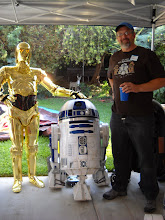So I glued 4 and 6 layer stacks together with some plastic glue I had. It was a watery kind labeled for Acrylic, but the dude at the warehouse assured me that it would work on the PVC too. Turns out it will work, but you really have to flood the surfaces (both of them) to get it to start chemically breaking down the plastic and make for a good bond between the layers.
Once I had those stacks dried, I cut them into a couple of exactly square 7 x 7" pieces. I laid those out with the circles--I can't recall the exact dimension. But I knew that I was going to be slicing my circles into half moons, so I made them bigger to account for the .1" saw blade cut out of the middle. I rough cut those half moons on the bandsaw, and the finished them down to (nearly) perfect semi-circles on the sander. I'm getting better at doing this. And this method rough cutting close on the bandsaw and then finishing on the sander is working well. My sander, as I have said before, can tilt up to 90 degrees so I can put pieces on the table and then run their edges onto the belt, kind of like a jointer.
So I sanded four pieces down to half moons that fit the blueprints. But then how to get then sliced off like wedges of an orange so that they would sit right on the sides of the angled feet? I played around with the tilting table and the fences on my bandsaw and tested several pieces until I got the angle and the cut right, and then sliced them down to make orange wedges.

I don't know if the written description can make sense of it, but the picture shows the result. With many of these steps, you don't really understand the piece or how it works with the R2 overall until you actually get in there are start trying to build it. Then you get intimately familiar with it. So if you are trying to make the half moons, dive in and email me too.
The next trick on these is going to be fashioning a 2" by 2.5" by .125 (or so) rectangle that mounts right on the outside. Look at this picture of an ILM R2:

The tricky part about this rectangle is that it tapers in thickness from .125 (if I remember right) down at the bottom, to almost nothing at the top where it meets the curve and has those two routed slots in it. Making the piece is easy, figuring out a way to cleanly remove material to make the taper has got me stumped. You can't just rub this thing on sandpaper, unless you want to spend an hour on each of 4 pieces. As usual, I want a repeatable, power tool solution to the problem. Right now I am thinking of building some sort of little jig that will allow me to sand or cut the pieces consistently and quickly.







No comments:
Post a Comment